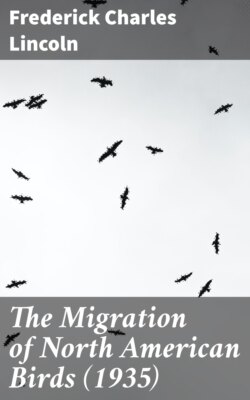Читать книгу The Migration of North American Birds (1935) - Frederick Charles Lincoln - Страница 5
На сайте Литреса книга снята с продажи.
HISTORICAL ACCOUNTS
ОглавлениеTable of Contents
Of observers whose writings are extant, Aristotle, naturalist and philosopher of ancient Greece, was one of the first to discuss the subject of bird migration. He noted that cranes traveled from the steppes of Scythia to the marshes at the headwaters of the Nile, and that pelicans, geese, swans, rails, doves, and many other birds likewise passed to warmer regions to spend the winter. In the earliest years of the Christian era, the elder Pliny, Roman naturalist, in his Historia Naturalis, repeated much of what Aristotle had said on migration, and added comments of his own concerning the movements of the European blackbird, the starling, and the thrushes.
In spite of the keen perception shown in some of his statements, Aristotle also sponsored some superstitions on bird migration that persisted for several centuries. One of these, that of hibernation, became so firmly rooted that in 1878, the American ornithologist Coues (20)[2] listed the titles of no less than 182 papers dealing with the hibernation of swallows (Hirundinidae). The hibernation theory accounted for the autumnal disappearance of certain species of birds as their passing the cold season in a torpid state, hidden in hollow trees, caves, or the mud of marshes. Aristotle ascribed hibernation not only to swallows but also to storks, kites, doves, and others. Some early naturalists wrote fantastic accounts of flocks of swallows seen congregating in the marshes until their accumulated weight bent into the water the reeds on which they clung and thus submerged the birds. It was even recorded that when fishermen in northern waters drew up their nets they sometimes had a mixed "catch" purported to consist of fish and hibernating swallows. Clarke (4) quotes Olaus Magnus, Archbishop of Upsala, who in 1555 published a work entitled "Historia de Gentibus Septentrionalibus et Natura", wherein he observed that if swallows so caught were taken into a warm room they soon begin to fly about but would live only a short time.
[2] Italic numbers in parentheses refer to the Bibliography, p. 66.
The hibernation theory survived for more than 2,000 years and is still occasionally repeated by credulous persons to account for failure to locate definitely the winter home of the chimney swifts (Chaetura pelagica), which each autumn gather in immense flocks in southern Georgia and northern Florida and then suddenly disappear. There are, however, records of occurrence during migration for a few points in the West Indies, Mexico, and Central America, and it is probable that these birds spend the winter season in the great rain-forest area of the Amazon Valley in Brazil, passing most of the daytime high in the air with other swifts that are local residents.
Aristotle was also the originator of the theory of transmutation, basing it upon the fact that frequently one species will arrive from the north just as another species departs for more southerly latitudes. From this he reasoned that although it was commonly believed that such birds were of two different species, there really was only one, and that this one assumed the different plumages to correspond with the summer and winter seasons.
Probably the most remarkable theory that has been advanced to account for migration is contained in a pamphlet mentioned by Clarke (4, v. 1, pp. 9-11), as published in 1703 under the title: "An Essay Toward the Probable Solution of this Question: Whence Come the Stork and the Turtle, the Crane, and the Swallow, when they Know and Observe the Appointed Time of their Coming." It was written "By a Person of Learning and Piety", whose "probable solution" was that migratory birds flew to the moon and there spent the winter.
Some who easily accepted the disappearance of the larger birds as migratory travelers were unable to understand how the smaller species, some of them notoriously poor fliers, could make similar journeys. They contended that the larger species, as the storks and cranes, carried their smaller companions as living freight. In some of the Mediterranean countries it is still believed that these broad-pinioned birds serve as aerial transports for the hosts of small birds that congregate on the shores of the Mediterranean Sea, awaiting opportunity for this kind of passage to their winter homes in Africa. Similar beliefs are found among some tribes of North American Indians.
